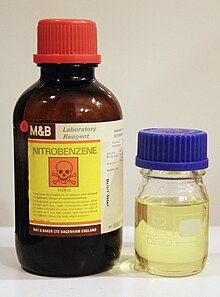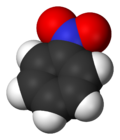Our website is made possible by displaying online advertisements to our visitors.
Please consider supporting us by disabling your ad blocker.
Nitrobenzene
| |||
 | |||
| Names | |||
|---|---|---|---|
| Preferred IUPAC name
Nitrobenzene | |||
| Other names
Nitrobenzol
Nitritebenzene Oil of mirbane | |||
| Identifiers | |||
3D model (JSmol)
|
|||
| 507540 | |||
| ChEBI | |||
| ChEMBL | |||
| ChemSpider | |||
| ECHA InfoCard | 100.002.469 | ||
| EC Number |
| ||
| 50357 | |||
| KEGG | |||
PubChem CID
|
|||
| RTECS number |
| ||
| UNII | |||
CompTox Dashboard (EPA)
|
|||
| |||
| |||
| Properties | |||
| C6H5NO2 | |||
| Molar mass | 123.11 g/mol | ||
| Appearance | yellowish, oily liquid[1] | ||
| Odor | pungent, like paste shoe polish[1] to almond-like | ||
| Density | 1.199 g/cm3 | ||
| Melting point | 5.7 °C (42.3 °F; 278.8 K) | ||
| Boiling point | 210.9 °C (411.6 °F; 484.0 K) | ||
| 0.19 g/100 ml at 20 °C | |||
| Vapor pressure | 0.3 mmHg (25°C)[1] | ||
| -61.80·10−6 cm3/mol | |||
Refractive index (nD)
|
1.5215 | ||
| Viscosity | 1.8112 mPa·s[2] | ||
| Hazards | |||
| GHS labelling: | |||
 
| |||
| Danger | |||
| H301, H311, H331, H351, H360, H372, H412 | |||
| P201, P202, P260, P261, P264, P270, P271, P273, P280, P281, P301+P310, P302+P352, P304+P340, P308+P313, P311, P312, P314, P321, P322, P330, P361, P363, P403+P233, P405, P501 | |||
| NFPA 704 (fire diamond) | |||
| Flash point | 88 °C (190 °F; 361 K) | ||
| 480 °C (896 °F; 753 K) | |||
| Explosive limits | 1.8%-?[1] | ||
| Lethal dose or concentration (LD, LC): | |||
LD50 (median dose)
|
780 mg/kg (rat, oral) 600 mg/kg (rat, oral) 590 mg/kg (mouse, oral) [3] | ||
LDLo (lowest published)
|
750 mg/kg (dog, oral)[3] | ||
| NIOSH (US health exposure limits): | |||
PEL (Permissible)
|
TWA 1 ppm (5 mg/m3) [skin][1] | ||
REL (Recommended)
|
TWA 1 ppm (5 mg/m3) [skin][1] | ||
IDLH (Immediate danger)
|
200 ppm[1] | ||
| Related compounds | |||
Related compounds
|
Aniline Benzenediazonium chloride Nitrosobenzene | ||
Except where otherwise noted, data are given for materials in their standard state (at 25 °C [77 °F], 100 kPa).
| |||
Nitrobenzene is an aromatic nitro compound and the simplest of the nitrobenzenes, with the chemical formula C6H5NO2. It is a water-insoluble pale yellow oil with an almond-like odor. It freezes to give greenish-yellow crystals. It is produced on a large scale from benzene as a precursor to aniline. In the laboratory, it is occasionally used as a solvent, especially for electrophilic reagents. As confirmed by X-ray crystallography, nitrobenzene is a planar molecule.[4]
- ^ a b c d e f g NIOSH Pocket Guide to Chemical Hazards. "#0450". National Institute for Occupational Safety and Health (NIOSH).
- ^ Ahluwalia, R.; Wanchoo, R. K.; Sharma, S. K.; Vashisht, J. L. (1996). "Density, viscosity, and surface tension of binary liquid systems: Ethanoic acid, propanoic acid, and butanoic acid with nitrobenzene". Journal of Solution Chemistry. 25 (9): 905–917. doi:10.1007/BF00972581. ISSN 0095-9782. S2CID 95126469.
- ^ a b "Nitrobenzene". Immediately Dangerous to Life or Health Concentrations (IDLH). National Institute for Occupational Safety and Health (NIOSH).
- ^ Olga V. Dorofeeva; Yuriy V. Vishnevskiy; Natalja Vogt; Jürgen Vogt; Lyudmila V. Khristenko; Sergey V. Krasnoshchekov; Igor F. Shishkov; István Hargittai; Lev V. Vilkov (2007). "Molecular Structure and Conformation of Nitrobenzene Reinvestigated by Combined Analysis of Gas-Phase Electron Diffraction, Rotational Constants, and Theoretical Calculations". Structural Chemistry. 18 (6): 739–753. doi:10.1007/s11224-007-9186-6. S2CID 98746905.
Previous Page Next Page





